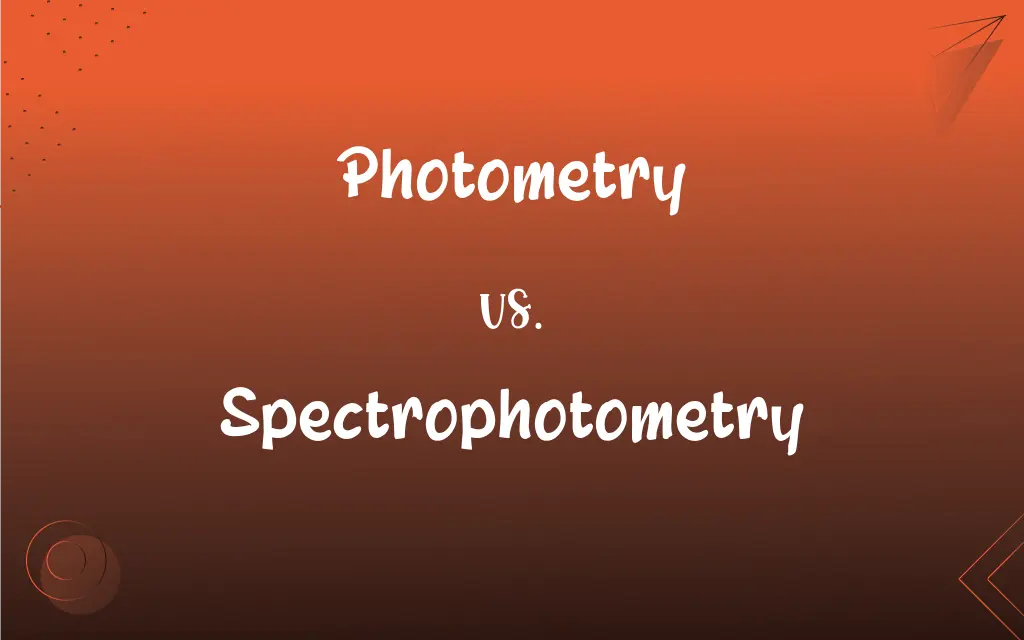Photometry vs. Spectrophotometry: What's the Difference?
By Janet White || Published on December 1, 2023
Photometry measures light intensity at a single wavelength; spectrophotometry measures light intensity across a spectrum of wavelengths.

Key Differences
Photometry is a technique that measures the intensity of light at a specific wavelength, often used in astronomy to gauge the brightness of stars. Spectrophotometry, on the other hand, extends this concept by measuring light intensity across a range of wavelengths, enabling detailed analysis of the light's spectral composition.
In photometry, the focus is on quantifying the amount of light, which is key in applications like light pollution studies. Spectrophotometry, contrasting with this, not only measures light but also analyzes its spectrum, making it crucial in chemical analysis to identify and quantify substances based on their spectral properties.
Photometry employs filters to isolate light of a specific wavelength, making it a simpler and often more cost-effective method. Conversely, spectrophotometry uses prisms or diffraction gratings to disperse light into its spectrum, providing a more comprehensive analysis but at a higher complexity and cost.
The application of photometry is primarily in fields where light intensity is the main concern, such as in visual ergonomics. Spectrophotometry, with its ability to analyze the spectrum, finds extensive use in fields like biochemistry and physics for material identification and characterization.
Photometry is about measuring light intensity at a particular wavelength, useful for basic light assessments. Spectrophotometry takes this a step further by analyzing the entire spectrum of light, making it indispensable for more complex scientific analyses.
ADVERTISEMENT
Comparison Chart
Measurement
Intensity at a single wavelength
Intensity across a spectrum
Use in Science
Light intensity measurement
Material analysis through spectral data
Equipment Complexity
Less complex, often uses filters
More complex, uses prisms or gratings
Cost
Generally more cost-effective
More expensive due to complexity
Applications
Used in astronomy, lighting studies
Used in chemical analysis, biochemistry
ADVERTISEMENT
Photometry and Spectrophotometry Definitions
Photometry
Photometry is used in astronomy to measure the brightness of celestial objects.
Astronomers rely on photometry to determine the distance of stars based on their luminosity.
Spectrophotometry
It's used to identify chemicals by analyzing their light absorption spectra.
The spectrophotometry results confirmed the presence of specific nutrients in the soil.
Photometry
Photometry is the science of measuring visible light in terms of its perceived brightness to the human eye.
In photometry, the luminous intensity of a light bulb is measured to determine its efficiency.
Spectrophotometry
It involves dispersing light into its component wavelengths for detailed analysis.
Spectrophotometry was crucial in studying the light absorption properties of new solar panels.
Photometry
It involves quantifying the intensity of light at specific wavelengths.
Photometry was used to assess the light emission characteristics of different LED lights.
Spectrophotometry
Spectrophotometry is the measurement of light absorption or transmission across a spectrum.
Spectrophotometry revealed the concentration of pollutants in the water sample.
Photometry
It's a technique to analyze the light output of sources like lamps and screens.
Photometry helped in designing a more energy-efficient lighting system for the office.
Spectrophotometry
Spectrophotometry can quantify the purity of substances based on spectral data.
Using spectrophotometry, the lab verified the purity of the pharmaceutical compound.
Photometry
Photometry can be used to evaluate the effect of light on human perception and comfort.
The photometry study showed that warmer light colors improved employee comfort levels.
Spectrophotometry
Spectrophotometry is essential in biochemistry for analyzing molecular structures.
The spectrophotometry test helped in understanding the protein's structure in the sample.
Photometry
Measurement of the properties of light, especially luminous intensity.
Spectrophotometry
An instrument used to determine the relative intensity of various wavelengths in a spectrum of light.
Photometry
(physics) The measurement of various aspects of light, especially its intensity.
Spectrophotometry
The quantitative analysis of electromagnetic spectra by use of a spectrophotometer; especially in order to determine the structure or quantity of a substance
Photometry
(astronomy) The measurement of the intensity and spectrum of light from stars.
Spectrophotometry
The art of comparing, photometrically, the brightness of two spectra, wave length by wave length; the use of the spectrophotometer.
Photometry
That branch of science which treats of the measurement of the intensity of light.
Spectrophotometry
The art or process of measuring the degree of absorption of light at different wavelengths by a chemical substance, by means of a spectrometer or spectrophotometer. It is a technique for chemical analysis.
Photometry
Measurement of the proterties of light (especially luminous intensity)
FAQs
What is spectrophotometry?
It measures light intensity across a spectrum of wavelengths.
Is photometry limited to visible light?
Primarily, but it can extend to near-infrared and ultraviolet ranges.
How is photometry used in astronomy?
It measures the brightness of stars and celestial objects.
What is the main application of spectrophotometry?
It's widely used in chemical analysis and biochemistry.
Is spectrophotometry important in pharmaceuticals?
Absolutely, for drug purity testing and formulation.
How does spectrophotometry benefit medical research?
It's used in diagnosing diseases and analyzing biological samples.
What is photometry?
It's the measurement of light intensity at a specific wavelength.
Is photometry useful in environmental studies?
Yes, especially in light pollution and ecological impact assessments.
What industries rely heavily on spectrophotometry?
Chemical, pharmaceutical, environmental, and food industries.
Can spectrophotometry identify substances?
Yes, by analyzing light absorption and emission spectra.
Can photometry measure the color of light?
Not directly; it measures intensity, while color requires spectral analysis.
Does photometry require specialized equipment?
Yes, like photometers and light meters, but less complex than spectrophotometers.
How accurate is photometry?
Quite accurate for light intensity, but limited in spectral analysis.
How does spectrophotometry assist in environmental monitoring?
By detecting and quantifying pollutants in air and water.
Can photometry help in energy conservation?
Yes, by optimizing lighting efficiency and reducing waste.
Can photometry be used in interior design?
Yes, for optimal lighting design and visual comfort.
Are there any limitations to photometry?
Its primary limitation is the lack of spectral data analysis.
What role does spectrophotometry play in quality control?
It ensures product consistency in industries by analyzing chemical compositions.
Does spectrophotometry have applications in food industry?
Yes, in analyzing food color, safety, and ingredients.
Is spectrophotometry used in art restoration?
Indeed, to analyze pigments and materials without damaging the artwork.
About Author
Written by
Janet WhiteJanet White has been an esteemed writer and blogger for Difference Wiki. Holding a Master's degree in Science and Medical Journalism from the prestigious Boston University, she has consistently demonstrated her expertise and passion for her field. When she's not immersed in her work, Janet relishes her time exercising, delving into a good book, and cherishing moments with friends and family.








































































